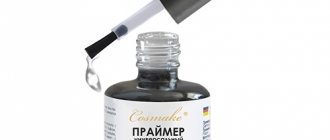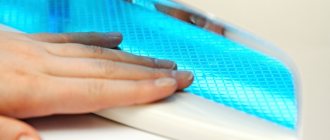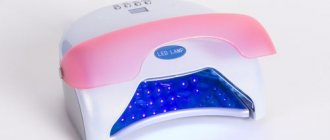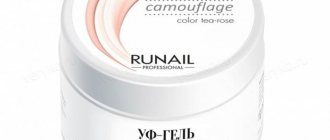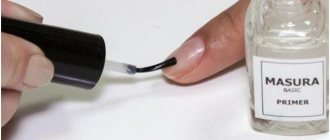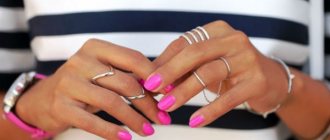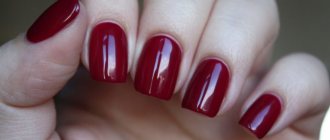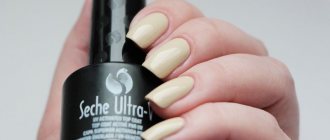Design and principle of operation of the lamp
Even a novice nail technician can use a lamp to dry gel polish. It must be remembered that there are several main types of this device. Each of them must be used depending on the selected material for work.
Today, there are three types of such lamps that work on a similar principle: ultraviolet lamp (UV), light-emitting diode (LED) and gas-light lamp (CCF). All 3 varieties differ in operation, although the principle itself remains similar. Each such lamp has its own advantages and disadvantages. A gas light bulb is most often found in conjunction with UV or LED and is, rather, an auxiliary technology for working with certain materials that require a separate special effect.
Reasons for curdling gel polish
One of the reasons for gel polish curdling is its dubious quality. If the master is confident in the quality of the material, then you should pay attention to the drying time and technology. Colored gel polishes require longer drying times due to their dense structure. Don’t forget that you need to dry each applied layer separately: first the base, then the first layer of gel polish, the second layer of gel polish and top coat.
Poor drying can also be caused by a broken lamp. Each device has its own expiration date, and some light bulbs may fail. In this case, they should be replaced. However, this only applies to UV lamps, because LED bulbs cannot be replaced.
When working with gel polish, there may be a burning sensation in the nail area. The reason for this may be a damaged nail plate. To avoid such cases, you should apply a thin layer of gel polish.
UV lamps
They were the very first to appear on the market and continue to be popular to this day. The main advantage is their power, which determines the rate at which the varnish hardens. A lamp may contain one or more lamps. Each bulb is 9 W. If there are two lamps, then the total power will be 18 W, etc. In the most powerful lamp, whose power is 36 W, the gel dries in 1-2 minutes.
On a note! In the case of professional UV lamps, it is possible to dry both hands at once, but such devices are not suitable for use at home. These lamps often have a timer that allows you to set the required time.
A significant disadvantage of UV lamps is the harmful effect they have on the human body. Ultraviolet radiation is harmful to human eyes and skin, and frequent use of the device can negatively affect nails.
How to increase the drying speed of gels?
If a UV device is used to polymerize gel polish, then this process can only be accelerated using an LED or CCFL lamp. In addition, the drying speed is also affected by the power of the device; the more powerful the lamp, the faster the polymerization. To cover nails, you need to use only high-quality materials that quickly set on the nail plate and have an average concentration. The best option would be to buy two devices for each hand.
Stores sell special gel polishes that do not require the use of lamps to dry. Some materials polymerize when exposed to cold water. Remember that the speed of creating a manicure also depends on the experience of the master, so with every day of practice it will only increase, and the duration of the procedure will decrease.
The nail industry is developing every day and introducing new products. Which lamp to use for drying a colored coating depends on many factors: the color of the coating, the base and top used, and the conditions in which the manicure is created (salon or at home). For home use, it is enough to buy a 24 and 36 W UV device, but for salon use, LED or hybrid lamps are optimal.
Gel polish is a nail coating that is distinguished by its attractive appearance and durability. The average wear time of gel polish is two weeks, however, if you use high-quality materials and follow all the rules of applying the coating, a manicure can maintain an impeccable appearance for a longer period. One of the conditions for a high-quality manicure with gel polish is high-quality polymerization of each layer in a special lamp. In this article we will tell you how long it takes to dry gel polish, and which lamp is best to use for this.
Lamp for gel polish
LED lamp
This type of lamp is more modern. Ultraviolet radiation comes from the LED. This technology allows the gel to harden in half a minute . Drying time is significantly reduced. The varnish is applied in a similar way, in three stages, between which drying takes place.
LEDs, unlike UV lamps, are practically harmless. In addition, they work much longer. The service life of such a lamp can reach 40-50 thousand hours.
Important! Unfortunately, the device is not capable of drying all materials. Some gel polishes are neutral to the effects of LEDs.
Dryers with this type of emitters are slightly more expensive than their UV counterparts. LED lamps, as a rule, cannot be replaced due to their durability. If the lamps burn out, the device is simply thrown away.
Main differences:
- UV uses a fluorescent light bulb, LED uses a light emitting diode;
- The UV lamp has a shorter lifespan and is harmful to the skin and eyes;
- LED does not work with all types of gel polishes;
- LED dries much faster;
- Low power UV units do not dry the gel properly.
Advice! Experienced users know that for optimal performance it is better to choose a hybrid device that contains both LED and UV technologies.
Terminology
Tunnel
— device for polymerization of varnishes and gels.
Photoinitiator
- a substance contained in all gels, which, under the influence of UV rays, starts the curing process.
Polymerization
- gel curing process.
Why is having a lamp so important? - You ask.
The thing is that most nail coatings, with the exception of acrylic and varnish, require so-called polymerization - the process of converting the gel from a plastic form into a solid one. Because gels by themselves are not able to hold their shape. It should be taken into account that the higher the power of your lamp, the faster and better the gel will polymerize.
So, first of all, let's deal with the abundance of varieties. Modern lamps for nail extensions are divided as follows:
To size:
small and large (professional).
Small UV lamp for nail extension
This is clear, small ones are cheaper, so they are used mainly by novice craftsmen. They are also suitable for those who do extensions at home.
The main disadvantage of such lamps is that they are low-power and space-saving.
Large ones, in turn, use masters who professionally do nail extensions in a salon or have enough free space in their office.
Their advantage lies in the spaciousness of the internal chamber, which allows you to freely place two hands at once. And, most importantly, such lamps are powerful, and this significantly reduces the time spent on drying the gel.
When you have decided on the size of your future lamp, you will be faced with what type to choose. Today there are three main types:
- UV lamps
- LED lamps
- CCFL lamps
Professional UV lamp for nail extension
1 UV lamp
is the most common and affordable product on the market. Most beginners and professionals choose this type of lamp because they have several advantages:
- The price is relatively low
compared to other types of lamps. - Replacing lamps
: When they burn out, you can easily replace them with new ones. - Wide power range
(from 9 to 54 Watts). This makes it possible to choose a lamp specifically for your type of activity.
Colored and colorless gels polymerize at different rates. It all depends on how much photoinitiators they contain - substances that make the gel harden.
The main disadvantage is the “drying” time of the gel. In tunnels of this type, the gel polymerizes in 1-3 minutes, depending on the nail coating. Also, fluorescent lamps will have to be replaced after 3000 hours of operation.
Professional LED lamp for nail extensions
2The next type of tunnels with LED lamps
. A relatively new technology in the field of nail extensions. The secret is that instead of conventional fluorescent lamps, LEDs are used in these tunnels.
Main advantages of LED lamps:
- Duration of operation up to 50,000 hours
, which in reality gives 6 years of continuous operation. Impressive, isn't it? - The curing speed of the gel is several times higher
than that of standard lamps. - Ultraviolet LEDs do not lose
UV power. This means that you don’t have to worry that over time the gel will “dry” longer or worse. - LEDs, compared to fluorescent lamps, do not contain mercury
, which makes them absolutely harmless to the environment in case of damage and disposal.
However, there are also disadvantages:
- The cost of
this lamp is several times higher than a conventional UV tunnel. And good professional models will cost you from 200 USD. and higher. - These lamps are not intended
for the polymerization of some solid gels (when purchasing a gel, check with the seller whether they “dry” in LED lamps)
Professional CCFL+LED lamp
3 And finally, the latest trend is hybrid CCFL+LED lamps
.
As the name implies, these are universal tunnels with a full spectrum of ultraviolet radiation. The symbiosis of LED and UV lamps with a “cold” cathode produces light waves with a length of 350-400 nm, and this is enough to “dry” all currently known gels
.
The drying speed is 4 times higher than a standard lamp, and the duration of continuous operation reaches 80,000 hours
.
Everything is clear here: the best, fastest and most durable lamps on the market. As you would expect - the most expensive
.
Which lamp for nail extensions
the choice depends only on you and your preferences. And if our article helped you, don’t forget to like it. And if you have any questions, ask them in the comments and we will definitely answer them.
How to use a lamp at home
Modern models of lamps for drying gel polish are easy to use and do not require specific skills to use them. At home, operating the device will be no different from working in a nail salon. First of all, you need to carefully study the instructions included with each device. The first thing you should pay attention to is what kind of varnishes the model you have works with . Some lamps only work with certain types of materials, while others are universal.
Understanding the principle of the structure and operation of the device is not difficult. Most of the devices are made in a similar style, and resemble a miniature garage. On the top of the dryer there is a control, which is most often push-button. There are usually two buttons, but there may be more. If the device is hybrid, then on the case there will be an additional button for switching between lamp operating modes.
The lamp for drying gel polish works quite simply. The principle of operation comes down to pressing a button and holding your nails under the lighting. In some models equipped with sensors, there is no need to even press a button; the device turns on itself when the palm of your hand comes under the light source. If the device has a screen with a timer, then all you need to do is focus on it. However, if there is no timer, any stopwatch will do.
Important! You should not expose your nails to the lamp, or, conversely, remove your hand from the lighting ahead of time. The materials are very demanding in terms of strict adherence to time regulations. If you remove your nails earlier, the gel will dry unevenly.
Each coating manufacturer may have its own drying recommendations. Here are the average data for UV and LED lamps:
So, the main points of operation:
- know what materials the selected lamp model works with;
- read the instructions before use;
- observe timing, do not overexpose and do not remove nails ahead of time;
- take precautions.
During operation, the device may be damaged. In this case, it is necessary to place all damaged parts in a plastic (if possible sealed) container as soon as possible. To eliminate the undesirable consequences of caustic mercury vapor, you must contact a special service.
How to properly dry gel polish in a lamp
To ensure that the gel polish dries well, you must keep the following in mind:
- Some types of gel polish contain substances that change their structure under the influence of ultraviolet rays. Therefore, before placing your nails under the lamp, you need to carefully read the instructions.
- Before work, you need to carefully inspect the lighting fixture. If there is any external or internal damage, do not use the device.
- After each client, the lamp must be disinfected without fail.
- Once a light bulb has expired, it needs to be replaced, even if it still shines brightly. If you use a lamp that has expired, the coating will not be durable.
Is there any harm from a nail lamp?
Many women wonder whether a nail drying lamp is harmful. Often, concerns can discourage a user from purchasing a dryer or visiting a nail salon. Fears for your health are far from unfounded. The question arose when the story of two women who were diagnosed with skin cancer was widely publicized. They both used UV nail dryers frequently. However, in a subsequent study of a larger sample of patients, no such deviations were identified. From which we can conclude that the occurrence of such diseases can be attributed to a special case and characteristics of the body, and not to the potentially harmful effects of UV rays.
Some experts continue to argue that even more intense exposure to UV rays on human skin and eyes is completely safe, and in some cases even beneficial. Of course, even with a minimal probability of developing terrible diseases, some people will experience justified fears.
To minimize negative consequences, doctors recommend using a dryer at a certain interval: do not change the nail polish more than once a week. This intensity can be hazardous to nail health, regardless of the potential harmful nature of UV exposure. On average, a well-made varnish coating lasts from two to three weeks. Even if you dry your hair 1-2 times a month, you most likely won’t have any serious consequences.
On a note! Some salons have recently offered special gloves that protect the skin from direct UV rays.
What you need to know about the dangers of using nail dryers:
- Frequent use of any procedure can harm the body;
- fixed time and local exposure to a small area of skin minimizes possible harmful effects;
- the harm from a lamp for drying nails has not been proven, but is only a hypothesis, the correctness of which everyone assesses for himself;
- if you maintain a certain interval and do not overexpose your nails under the dryer, and also use special gloves, the harm from exposure to UV rays is practically reduced to nothing;
- LED lamps are less harmful due to their low light intensity.
